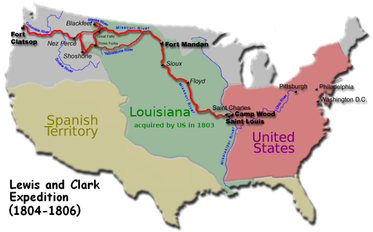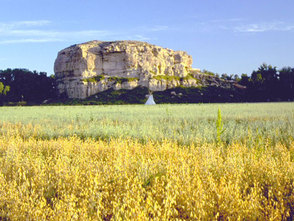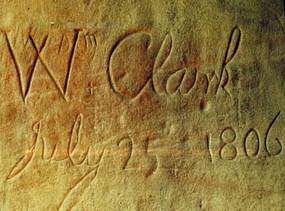 Route of Lewis and Clark Expedition
Route of Lewis and Clark Expedition But the reason for all the attention is clear: Lewis and Clark spent more time altogether in Montana than in any other place on their expedition. Even with all of those hours, days, and weeks of time they spent in the state, however, there is almost no physical proof that they were even here. Except for one grainy inscription etched into a sandstone pillar near Billings.
Early History
 Pompey's Pillar
Pompey's Pillar During that time large deposits of such sedimentary material as sandstones, clays, and mudstones were washed away from mountains and deposited in low-level areas. The whole area at that point in time was warm and even sub-tropical, and crocodile fossils have been found to back up the claim. That also points to an annual cycle with no prolonged period of cold, something unheard of in Montana today.
Going Solo
 William Clark, by Charles Willson Peale
William Clark, by Charles Willson Peale Clark also made a note in his journal about the native’s etchings, which consisted of animal pictures for the most part. These rock etchings, or petroglyphs, that Clark saw were probably there for eight centuries before he added his name to the list, and probably came from Shoshone Indians.
Changes over Time
 Clark's Inscription
Clark's Inscription Clark named the tower “Pompy’s Tower,” in reference to the nickname he had begun using for Sacagawea’s young son, Jean Baptiste Charbonneau. The name lasted until 1814 when “Pompey’s Tower” became Pompey’s Pillar.
Those that have visited the pillar in the past haven’t always had the best of luck. When Clark and his men tried to bed down for the night, they couldn’t get to sleep because of all of the noise the buffalo in the area were making. And when George Armstrong Custer stayed the night in 1875 he and his men came under fire from nearby Indians.
Pompey’s Pillar still stands, and those who visit today don’t have to worry about sleepless nights or Indian attacks. A new interpretative center opened in 2006, devoted to all things Lewis and Clark in the area, and the site sees more than 50,000 visitors each year.
Fritz, Harry W. The Lewis and Clark Expedition. Greenwood Publishing Group: Westport, 2004. p 143.
"National Monument detail table as of April 2012". Bureau of Land Management. Retrieved 2013-03-20.
“Pompey’s Pillar.” Montana: Official Montana Travel Site. Retrieved 2013-03-20. http://www.visitmt.com/experiences/history/lewis_and_clark/Pompeys_Pillar/

